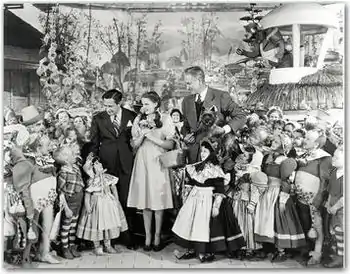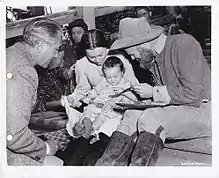Victor Fleming
Victor Lonzo Fleming (February 23, 1889 – January 6, 1949) was an American film director, cinematographer, and producer. His most popular films were Gone with the Wind, for which he won an Academy Award for Best Director, and The Wizard of Oz (both 1939). Fleming has those same two films listed in the top 10 of the American Film Institute's 2007 AFI's 100 Years...100 Movies list.
Victor Fleming | |
|---|---|
.jpg.webp) Fleming in 1927 | |
| Born | Victor Lonzo Fleming February 23, 1889 |
| Died | January 6, 1949 (aged 59) |
| Resting place | Hollywood Forever Cemetery |
| Occupation |
|
| Years active | 1910–1949 |
| Known for | |
| Spouse(s) | Lucile Rosson (1895-1966) (1933–1949) |
Biography
Early life
Fleming was born at the Banbury Ranch near what is now La Cañada Flintridge, California, the son of Eva (née Hartman) and William Richard Lonzo Fleming.[1]
Career
He served in the photographic section for the United States Army during World War I, and acted as chief photographer for President Woodrow Wilson in Versailles, France.[2] He showed a mechanical aptitude early in life; while working as a car mechanic, he met the director Allan Dwan, who took him on as a camera assistant. He soon rose to the rank of cinematographer, working with both Dwan and D. W. Griffith, and directed his first film in 1919.[3]
Many of his silent films were action movies, often starring Douglas Fairbanks, or Westerns. Because of his robust attitude and love of outdoor sports, he became known as a "man's director"; however, he also proved an effective director of women. Under his direction, Vivien Leigh won the Best Actress Oscar, Hattie McDaniel won for Best Supporting Actress, and Olivia De Havilland was nominated.
In the opinion of veteran cinematographer Archie Stout, of all the directors he worked with Fleming was the most knowledgeable when it came to camera angles and appropriate lenses.[4]
Metro-Goldwyn-Mayer
In 1932, Fleming joined MGM and directed some of the studio's most prestigious films. Red Dust (1932), Bombshell (1933), and Reckless (1935) showcasing Jean Harlow, while Treasure Island (1934) starring Wallace Beery and Captains Courageous (1937) with Spencer Tracy brought a touch of literary distinction to boy's-own adventure stories. His two most famous films came in 1939, when The Wizard of Oz was closely followed by Gone with the Wind.

Fleming's version of Dr. Jekyll and Mr. Hyde (1941), with Spencer Tracy, was generally rated below Rouben Mamoulian's 1931 pre-code version, which had starred Fredric March. Fleming's 1942 film version of John Steinbeck's Tortilla Flat starred Tracy, John Garfield, Hedy Lamarr, and Frank Morgan. Other films that Fleming made with Tracy include Captains Courageous (for which Tracy won his first Oscar), A Guy Named Joe, and Test Pilot. He directed Clark Gable in a total of five films – Red Dust, The White Sister, Test Pilot, Gone with the Wind, and Adventure.
Personal life
He owned the Moraga Estate in Bel Air, Los Angeles, California, then a horse ranch.[5][6][7] Frequent guests to his estate included Clark Gable, Vivien Leigh, Ingrid Bergman, and Spencer Tracy.[6]
He died en route to a hospital in Cottonwood, Arizona[8] after suffering a heart attack on January 6, 1949. His death occurred shortly after completing Joan of Arc (1948) with Ingrid Bergman, one of the few films that he did not make for MGM. Despite mixed reviews, Fleming's film version of the life of Joan received seven Oscar nominations, winning two.
Comment by Anne Revere
It was reported in James Curtis' book Spencer Tracy: A Biography[9] that Anne Revere once said Fleming was "violently pro-Nazi" and strongly opposed to the United States entering World War II. According to the Fleming biography Victor Fleming: An American Movie Master,[10] by author Michael Sragow, Fleming had once mocked the UK at the outset of World War II by taking a bet as to how long the country could withstand an attack by Germany.
The accuracy of Revere's characterization of Fleming has been disputed, however. According to Victor Fleming: An American Movie Master, Revere had made her comment because she felt she had been cast in the film The Yearling over Flora Robson because Robson was British. However, at the time of the casting, Fleming was working on the film Dr. Jekyll and Mr. Hyde, which featured a British producer and a cast largely composed of British or British Commonwealth actors. Furthermore, Revere did not know Fleming beyond their professional relationship.[10]
Filmography

- The Half-Breed (1916)
- When the Clouds Roll By (1919) (directorial debut)
- The Mollycoddle (1920)
- Mama's Affair (1921)
- Woman's Place (1921)
- The Lane That Had No Turning (1922)
- Red Hot Romance (1922)
- Anna Ascends (1922)
- Dark Secrets (1923)
- Law of the Lawless (1923)
- To the Last Man (1923)
- The Call of the Canyon (1923)
- Empty Hands (1924)
- Code of the Sea (1924)
- Adventure (1925)
- The Devil's Cargo (1925)
- A Son of His Father (1925)
- Lord Jim (1925)
- The Blind Goddess (1926)
- Mantrap (1926)
- The Way of All Flesh (1927)
- Hula (1927)
- The Rough Riders (1927)
- The Awakening (1928)
- Abie's Irish Rose (1928)
- Wolf Song (1929)
- The Virginian (1929)
- Common Clay (1930)
- Renegades (1930)
- Around the World in 80 Minutes with Douglas Fairbanks (1931)
- The Wet Parade (1932)
- Red Dust (1932)
- The White Sister (1933)
- Bombshell (1933)
- Treasure Island (1934)
- Reckless (1935)
- The Farmer Takes a Wife (1935)
- Captains Courageous (1937)
- Test Pilot (1938)
- The Wizard of Oz (1939)
- Gone with the Wind (1939)
- Dr. Jekyll and Mr. Hyde (1941)
- Tortilla Flat (1942)
- A Guy Named Joe (1943)
- Adventure (1945)
- Joan of Arc (1948) (final film)
References
- Michael Sragow (2013). Victor Fleming: An American Movie Master. University Press of Kentucky. p. 19.
- "Victor Fleming Biography". biography.com. Archived from the original on July 16, 2009. Retrieved June 26, 2010.
- Gabbard, Glen O.; Gabbard, Krin (1999). Psychiatry and the Cinema (2 ed.). Washington DC: American Psychiatric Press, Inc. p. 37. ISBN 0-88048-826-3.
- Donati, William (1996). Ida Lupino A Biography, University press of Kentucky. ISBN 0-8131-1895-6
- "Moraga Estate - History". May 8, 2013. Archived from the original on May 8, 2013.CS1 maint: bot: original URL status unknown (link)
- James, Meg (May 10, 2013). "Rupert Murdoch buys Moraga Vineyards estate in Bel Air". The Los Angeles Times. Los Angeles, California: Tronc. Retrieved June 28, 2018.
- Virbila, S. Irene (February 8, 2013). "Moraga Vineyards in Bel Air for sale". The Los Angeles Times. Los Angeles, California: Tronc. Retrieved June 28, 2018.
- "Prescott Evening Courier - Google News Archive Search". news.google.com. Retrieved November 30, 2014.
- Curtis, James (2011). Spencer Tracy: A Biography. New York City: Knopf Doubleday Publishing Group. p. 417. ISBN 978-0307262899.
- Sragow, Michael (2008). Victor Fleming: An American Movie Master. New York City: Pantheon Books. ISBN 978-0375407482.
External links
| Wikimedia Commons has media related to Victor Fleming. |
- Victor Fleming at IMDb
- Victor Fleming at AllMovie
- Victor Fleming at the TCM Movie Database

- The Real Rhett Butler – David Denby on Victor Fleming (The New Yorker)
- Victor Fleming at Find a Grave